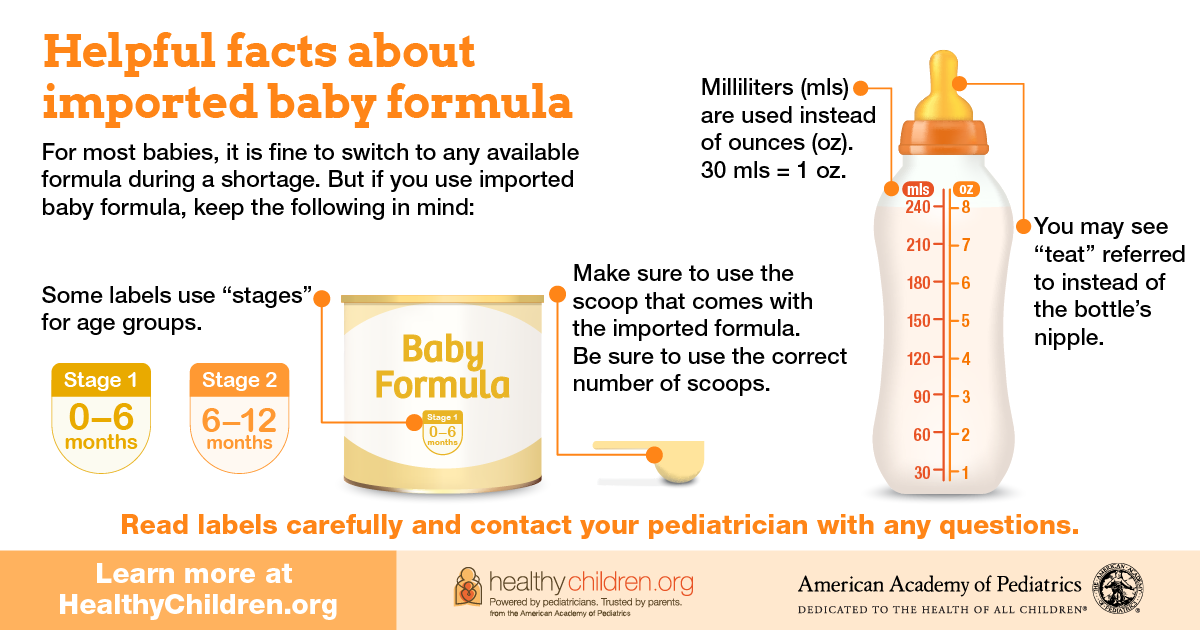To help ease a national shortage of baby formula in 2022, the U.S. government imported several brands that weren't previously sold here. The formula supply has improved, and imported formula is still being sold in the U.S., including goat's milk based infant formula.
If you see imported infant formula in your grocery stores or pharmacy, then it has been
imported based on special regulations and review to make sure it meets safety and nutritional standards. Most brands are widely used in Europe and Australia among other places with demonstrated safety.
How do these imported baby formulas compare to the brands I am used to seeing?
Many of the imported baby formulas will be very similar. But there are some that will be unique in the U.S. market, such as brands made from goat's milk protein. Some of the imported baby formulas are certified as organic, others are not. All should be labeled in English, though instructions for mixing them may use different standards of measurements, such as milliliters rather than ounces (read more below).

Are there any other differences in imported baby formulas?
There are several key differences to look for in imported formulas. First, you may see on the label "Stage 1" or "Stage 2." Stage 1 formulas are intended for babies in the first 6 months after birth, but generally can be used throughout the first year. Stage 2 are meant for babies 6 through 12 months of age.
Also, if you look at the labels, you may see some differences with typical American formulas. For example, the iron content is usually lower in imported formulas. This is because the rules in Europe and Australia for iron are different than in the United States. However, there is plenty of iron in these formulas, and you do not need to use an iron supplement unless advised by your pediatrician.
Goat's milk baby formula? Is that OK for an infant?
European and other international authorities have thoroughly reviewed the nutritional content of goat's milk. They've found that, when adapted for baby formula, goat's milk protein supports normal growth and development in infants. Some people believe that it may be tolerated better than formula based on cow milk or soy protein, with less upset stomachs or allergic responses, but that's not certain. However, raw goat's milk, like raw cow's milk, is not safe to feed a baby.
How do I mix imported baby formulas?
As with all baby formulas, read the label closely and follow the instructions exactly unless advised otherwise by your pediatrician. Most countries tell you the amount of water to add in "mls," which means milliliters.
If your baby bottles don't have ml scale markings, you may have to convert from ounces to milliliters.
Remember that 30 mls is one ounce. Some of the formulas will have you mix one scoop for each 2 ounces (60 mls) of water, while others will have you mix one scoop for each one ounce (30 ml) of water. Be sure to use the scoop that came with the container of baby formula you are using.
Also note: The imported baby formula’s instructions may refer to the bottle's nipple as the "teat."
As prepared, the imported baby formulas will have about the same amount of calories per serving as the usual U.S. formulas. If you have any questions about preparing the imported baby formula, be sure to talk with your pediatrician. Too much or too little
water used with powder or concentrate is dangerous for your baby.
Can I just import baby formula on my own?
Do not try to import yourself directly, because you can't be sure it meets U.S. safety standards. Contact your pediatrician if you are unsure if a formula has been properly imported.
More information